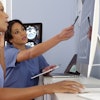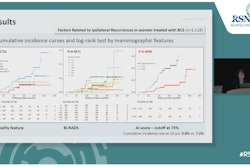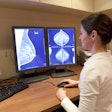Machine-learning models combining features from radiomics and contrast-enhanced mammography (CEM) can predict breast biopsy outcomes in high-risk women, suggest findings published January 10 in Academic Radiology.
Researchers led by Shandong Wu PhD, from the University of Pittsburgh in Pennsylvania highlighted the performance of their machine learning models, reporting that they can predict biopsy outcomes in women with BI-RADS 4 or 5 breast lesions.
“Using the radiomics models, which provide automated and objective analysis of CEM images, can help radiologists better discern those BI-RADS 4+ lesions that are unlikely to have a positive biopsy outcome, thus help reducing unnecessary biopsies for precision diagnosis of breast cancer,” Wu told AuntMinnie.com.
Nearly 10% of diagnostic breast exams are given BI-RADS 4 ratings, according to a 2023 report. Lesions in this category are considered suspicious, though the researchers noted the positive predictive value (PPV) for biopsy remains low. And while CEM could help predict biopsy outcomes, machine learning-based analysis of CEM is lacking, the researchers pointed out.
Wu and colleagues developed their own machine learning-based analysis of CEM by using computer-extracted radiomics and radiologist-assessed clinical descriptors. They tested their model for the prediction of breast biopsy outcomes for BI-RADS 4A, 4B, 4C, and 5 lesions.
To develop the models, a single breast radiologist manually segmented each lesion on every CEM view. The same radiologist randomly selected a subset of 30 cases out of the entire cohort to perform segmentation again without referring to the previous segmentation results. On segmented lesions, the team reported that 110 radiomics features were extracted. The model also incorporated clinical descriptors from four CEM views, including the left and right craniocaudal and the left and right mediolateral views.
The team included 201 women in the development and training cohort and another 86 women in an internal test set. It also evaluated the model’s performance with radiomics features only and CEM clinical descriptors only, along with a combination of these features.
The model achieved an AUC of 0.9 for radiomics-only, 0.81 for CEM clinical descriptors only, and 0.88 for all features combined.
For women with initial BI-RADS 4A or 4B scores, the combined model increased the PPVs for biopsy compared to radiologist-only PPVs.
| PPV for biopsy in women with BI-RADS 4 exams | ||
|---|---|---|
| BI-RADS category | Radiologist PPV | Machine-learning model (combined) PPV |
| BI-RADS 4A | 6% | 18% |
| BI-RADS 4B | 17% | 25% |
Wu said the results indicate the potential importance of clinical descriptors, which are not yet standardized, for CEM interpretation.
The study authors called for larger, multi-center datasets to validate their results. Wu told AuntMinnie.com that the team is working on expanding the study to verify their findings in datasets from external centers. He added that the researchers are looking into the effects of computing modeling using deep learning, “for which we have some initial results that have been reported in a conference, but we are furthering the study.”
The full study can be accessed here.




![Delineation workflow: The various steps of the contouring process: (a) the nipple is manually annotated (b) a reference point is placed 30 mm behind the nipple (c) 10 random theta/displacement values are selected to obtain the central point of each ROI (d) Regions of interest are placed on the image. (e) The resulting 10 ROIs obtained for a representative subject (viewing window [0 10000]). Images are published under a Creative Commons license (CC BY-NC-ND 4.0).](https://img.auntminnie.com/files/base/smg/all/image/2025/02/1_s2.0_S1120179725000523_gr1_lrg.67bcbbc3ac5a9.png?auto=format%2Ccompress&fit=crop&h=167&q=70&w=250)














